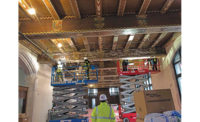With tight budgets and financing issues putting the squeeze on base-building projects during the recession, lingering opportunities in the renovation market have proved to be a lifeline for some contractors trying to keep crews working. Although analysts note that the renovation market was not immune from the economic downturn, the option of renovating or rehabilitating existing facilities has proved viable for some owners with immediate needs and limited funds.

“By and large, it has to do with access to capital,” explains Frank Ciminelli, senior vice president at Buffalo-based LPCiminelli, which has filled much of its backlog with renovation work. “Clients are trying to take advantage of whatever existing physical plant they have and make it work.”
Many contractors have focused on publicly funded projects for work in recent years, but with government budgets getting squeezed some hope to see an uptick in private work in 2011.
Institutional Opportunities
The biggest buoy for the market has come from the institutional sector. New York City has seen numerous mega-renovations continue through the recession, including the $1.9-billion United Nations Headquarters renovation, the $675-million Madison Square Garden project and $463 million of work at the Jacob K. Javits Convention Center.
Some smaller projects have provided a boost as well, including several renovations funded under the American Recovery and Reinvestment Act of 2009.
“Overall, the institutional market hasn’t been hit as hard as the commercial sector; and within the institutional sector, alterations comprise a larger share of activity than for commercial,” says Robert Murray, vice president for economic affairs at McGraw-Hill Construction. “Essentially, the alteration side has helped New York, New Jersey and Connecticut cushion the extent of the downturn.”
Institutional owners, who tend to occupy facilities longer than private owners, are more willing to invest in renovations, adds William Gilbane III, regional business development manager, Gilbane Building Co., Providence, R.I. Higher education and health care are Gilbane’s two primary markets right now. The company is managing the Fashion Institute of Technology’s $30-million A-Labs renovation and is completing work on the $35-million facade replacement at the New York City College of Technology’s Voorhees Hall in Brooklyn.
New York City-based Turner Construction is managing the $323-million renovation of the Welch Hall library at Rockefeller University in New York City and the renovation and expansion of Doty Hall for the State University of New York at Geneseo.
K-12 Assignments
Major renovation programs in K-12 are under way, but will close out in the coming years. LPCiminelli is working on the final two phases of Buffalo Public Schools’ reconstruction program, valued at between $315 million and $350 million. The work will reprogram and repurpose 15 schools through mid-2012.
In New York City, more than $4 billion of the School Construction Authority’s $11.3-billion five-year plan targets building repairs, system replacements, school reconfigurations and other upgrades.
Gilbane is starting a $325-million program for Rochester schools and a $138-million program for Syracuse. Meanwhile, the company is wrapping up work on New Haven’s renovation program. Most of these jobs are focused on renovations of existing facilities.
Gilbane is seeing other institutional opportunities as well. A $50-million project is under way at the Brooklyn Museum to renovate 40,000 sq ft and construct a 15,000-sq-ft extension. Gilbane recently completed restoring the interior courtyard’s glass block floor system and upgrades to the facility’s air-conditioning system.
Article toolbar

Post a comment to this article
Report Abusive Comment